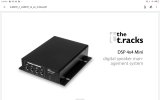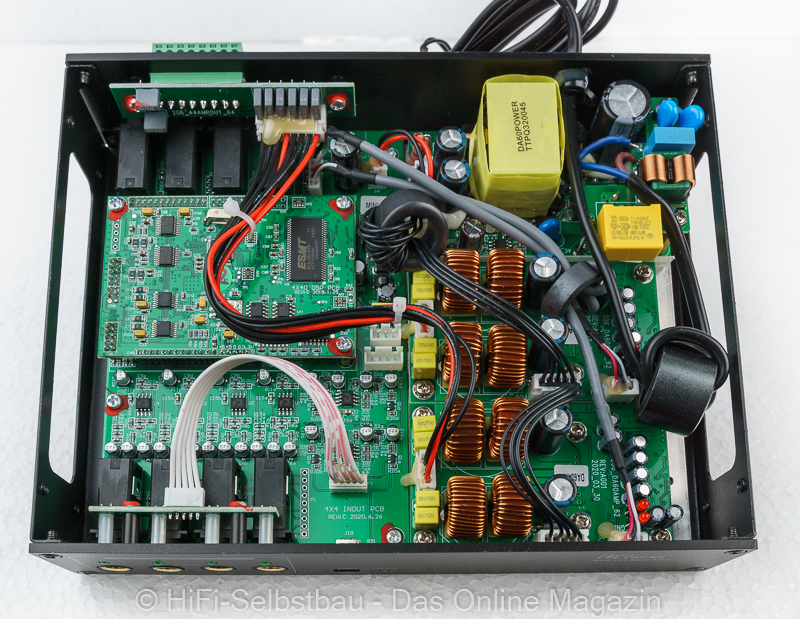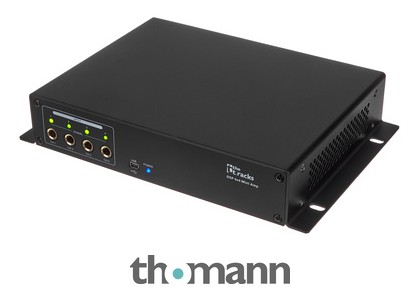This is a review and detailed measurements of the thomann t.racks DSP four by four matrix DSP. It was kindly purchased new by a member and costs just US $99.

I really like the form factor here and inclusion of brackets for mounting in cars and such. Inclusion of balanced I/O is much appreciated:

Despite shipping to US, the 12 volt adapter has the round European plug so I had to use my lab AC generator to power it (it has a universal outlet). Fortunately it is a standard voltage so you can use your own or tap into the power in a car/boat.
I was annoyed that the software to control it only came on a mini CD. I had to power up an old PC to read it as I could not find any online sources for it. Once there, the interface is surprisingly rich and very responsive. Here is the starting page:

And the crossover/parametric EQ:

thomann t.racks DSP Measurements
I only tested channels 1 and 2. Have no reason to think the other two act any different. Here is our dashboard:

At first I fed it 4 volt input which caused massive clipping. Above is about the highest level before clipping. Note that despite the interface showing no gain, we actually have some. Maybe there is a hidden gain setting some place I am not seeing. Here is a sweep showing performance relative to input level:

So be mindful of this.
Frequency sweep shows the classic cut off of internal sample rate of 44.1 or 48 kHz:

For grins, I turned on a couple of filters. FYI having the EQ in or bypass did not make any change to performance of the unit indicating that the pipeline is active at all times.
Dynamic range just matches that of 16 bit content:

Crosstalk is more than good enough for the class:

IMD distortion vs level shows that you should not high aspiration for fidelity and transparency:

Ditto for wideband response versus frequency:

Edit:
Pipeline latency is about 1 millisecond:

Here is the performance with unbalanced input and output at 2 volts in:

Not much penalty.
Conclusions
Given the nice build quality, four channels of processing, and extensive software control, my hope for performance was that it was not broken. t.racks clears that hurdle which is a relief. Getting all of this for $99 is a miracle. It is definitely job well done from start to finish.
I am happy to recommend the thomman t.racks 4x4 DSP Mini for everyday DSP applications.
-----------
As always, questions, comments, recommendations, etc. are welcome.
Any donations are much appreciated using: https://www.audiosciencereview.com/forum/index.php?threads/how-to-support-audio-science-review.8150/
I really like the form factor here and inclusion of brackets for mounting in cars and such. Inclusion of balanced I/O is much appreciated:
Despite shipping to US, the 12 volt adapter has the round European plug so I had to use my lab AC generator to power it (it has a universal outlet). Fortunately it is a standard voltage so you can use your own or tap into the power in a car/boat.
I was annoyed that the software to control it only came on a mini CD. I had to power up an old PC to read it as I could not find any online sources for it. Once there, the interface is surprisingly rich and very responsive. Here is the starting page:
And the crossover/parametric EQ:
thomann t.racks DSP Measurements
I only tested channels 1 and 2. Have no reason to think the other two act any different. Here is our dashboard:
At first I fed it 4 volt input which caused massive clipping. Above is about the highest level before clipping. Note that despite the interface showing no gain, we actually have some. Maybe there is a hidden gain setting some place I am not seeing. Here is a sweep showing performance relative to input level:
So be mindful of this.
Frequency sweep shows the classic cut off of internal sample rate of 44.1 or 48 kHz:
For grins, I turned on a couple of filters. FYI having the EQ in or bypass did not make any change to performance of the unit indicating that the pipeline is active at all times.
Dynamic range just matches that of 16 bit content:
Crosstalk is more than good enough for the class:
IMD distortion vs level shows that you should not high aspiration for fidelity and transparency:
Ditto for wideband response versus frequency:
Edit:
Pipeline latency is about 1 millisecond:
Here is the performance with unbalanced input and output at 2 volts in:
Not much penalty.
Conclusions
Given the nice build quality, four channels of processing, and extensive software control, my hope for performance was that it was not broken. t.racks clears that hurdle which is a relief. Getting all of this for $99 is a miracle. It is definitely job well done from start to finish.
I am happy to recommend the thomman t.racks 4x4 DSP Mini for everyday DSP applications.
-----------
As always, questions, comments, recommendations, etc. are welcome.
Any donations are much appreciated using: https://www.audiosciencereview.com/forum/index.php?threads/how-to-support-audio-science-review.8150/
Last edited:







